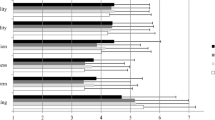Abstract
Letters of recommendation are central to the hiring process. However, gender stereotypes could bias how recommenders describe female compared to male applicants. In the current study, text analysis software was used to examine 886 letters of recommendation written on behalf of 235 male and 42 female applicants for either a chemistry or biochemistry faculty position at a large U.S. research university. Results revealed more similarities than differences in letters written for male and female candidates. However, recommenders used significantly more standout adjectives to describe male as compared to female candidates. Letters containing more standout words also included more ability words and fewer grindstone words. Research is needed to explore how differences in language use affect perceivers’ evaluations of female candidates.
Similar content being viewed by others
References
Biernat, M., & Eidelman, S. (2007). Translating subjective language in letters of recommendation: The case of the sexist professor. European Journal of Social Psychology (in press).
Greenwald, A., & Banaji, M. (1995). Implicit cognition: Attitudes, self-esteem, and stereotypes. Psychological Review, 102, 4–27.
Heilman, M. E. (1995). Sex stereotypes and their effects in the workplace: What we know and what we don’t know. Journal of Social Behavior and Personality, 10, 3–26.
Heilman, M. E. (2001). Description and prescription: How gender stereotypes prevent women’s ascent up the organizational ladder. Journal of Social Issues, 57, 657–674.
Heilman, M. E., Martell, R. F., & Simon, M. C. (1988). The vagaries of sex bias: Conditions regulating the undervaluation, equivalence, and overvaluation of female job applicants. Organizational Behavior and Human Decision Processes, 41, 98–110.
Kunda, Z., Davies, P., Adams, B., & Spencer, S. (2002). The dynamic time course of stereotype activation: Activation, dissipation, and resurrection. Journal of Personality and Social Psychology, 82, 283–299.
Mehl, M. R. (2005). Quantitative text analysis. In M. Eid & E. Diener (Eds.), Handbook of multimethod measurement in psychology (pp. 141–156). Washington, DC: American Psychological Association.
Nelson, D. (2005). A national analysis of diversity in science and engineering faculties at research universities. Retrieved January 15, 2007, from http://cheminfo.chem.ou.edu.
Neuberg, S. L., & Fiske, S. T. (1987). Motivational influences on impression formation: Outcome dependency, accuracy-driven attention, and individuating processes. Journal of Personality and Social Psychology, 53, 431–444.
Pennebaker, J. W., Francis, M. E., & Booth, R. J. (2001). Linguistic Inquiry and Word Count: LIWC2001. Mahwah, NJ: Lawrence Erlbaum Associates.
Poehlman, T. A., Uhlmann, E., Greenwald, A. G., & Banaji, M. R. (2007). Understanding and using the Implicit Association Test: III. Meta-analysis of predictive validity. Unpublished manuscript.
Rudman, L. A., & Glick, P. (1999). Feminized management and backlash toward agentic women: The hidden costs to women of a kinder, gentler image of middle manager. Journal of Personality and Social Psychology, 77, 1004–1010.
Rudman, L. A., & Glick, P. (2001). Prescriptive gender stereotypes and backlash toward agentic women. In L. L. Carli & A. H. Eagly (Eds.), Journal of Social Issues, 57, 743–762.
Trix, F., & Psenka C. (2003). Exploring the color of glass: letters of recommendation for female and male medical faculty. Discourse and Society, 14, 191–220.
Valian, V. (1998). Why so slow? The advancement of women. Cambridge, MA: M.I.T. Press.
Author information
Authors and Affiliations
Corresponding author
Additional information
This research was supported by National Institute of Mental Health Grant #1R01MH071749 to the first author and a University of Arizona grant from the College of Science Millennium Report Oversight Committee awarded to the third author.
Appendix
Appendix
Study-Defined Dimension Dictionaries
Standout words: excellen*, superb, outstanding, unique, exceptional, unparalleled, *est, most, wonderful, terrific*, fabulous, magnificent, remarkable, estraordinar*, amazing, supreme*, unmatched
Ability words: talent*, intell*, smart*, skill*, ability, genius, brilliant*, bright*, brain*, aptitude, gift*, capacity, propensity, innate, flair, knack, clever*, expert*, proficient*, capable, adept*, able, competent, natural*, inherent*, instinct*, adroit*, creative*, insight*, analytical
Grindstone words: hardworking, conscientious, depend*, meticulous, thorough, diligen*, dedicate, careful, reliab*, effort*, assiduous, trust*, responsib*, methodical, industrious, busy, work*, persist*, organiz*, disciplined
Teaching words: teach, instruct, educat*, train*, mentor, supervis*, adviser, counselor, syllabus, syllabus, course*, class, service, colleague, citizen, communicate*, lectur*, student*, present*, rapport
Research words: research*, data, study, studies, experiment*, scholarship, test*, result*, finding*, publication*, publish*, vita*, method*, scien*, grant*, fund*, manuscript*, project*, journal*,theor*, discover*, contribution*
Note. * indicates that any word containing the letter string that precedes or follows the asterisk should be counted.
Rights and permissions
About this article
Cite this article
Schmader, T., Whitehead, J. & Wysocki, V.H. A Linguistic Comparison of Letters of Recommendation for Male and Female Chemistry and Biochemistry Job Applicants. Sex Roles 57, 509–514 (2007). https://doi.org/10.1007/s11199-007-9291-4
Received:
Accepted:
Published:
Issue Date:
DOI: https://doi.org/10.1007/s11199-007-9291-4




